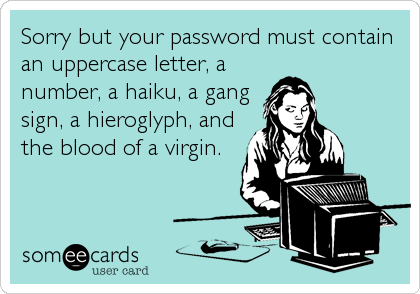On the topic of password security… Who came up with this?

We’ve all been there, navigating the treacherous asteroid fields of Hoth that is internet sign-ups. You’re readying yourself to join a new online Rebel Alliance, and suddenly, you’re under attack. It’s not an ambush of Stormtroopers, nor is it intrusive ads that feel as unwelcome as a Bantha in a starship, but something arguably more tiresome: password requirements.

The infamous “Your password must be as complex as the Millennium Falcon’s schematics, including an uppercase letter, a lowercase letter, a number, a haiku, an Ewok dance sequence, a Tatooine hieroglyph, and the essence of a Jedi” (alright, maybe not the last four, but it certainly feels like navigating the Kessel Run). The question is, who is this Sith Lord designing these convoluted rules, and do they truly enhance our cybersecurity?
Unmasking the Sith Lord: Password Complexity Rules⌗
Password complexity rules were designed with a simple protocol in mind, as simple as C-3PO’s primary function: make it harder for Sith-like bad actors to guess your password. By inserting the diversity of characters as varied as the species in Mos Eisley Cantina, the thought process was that we’d exponentially increase the possible combinations, thus making brute-force attacks (where hackers operate like droids systematically checking all possible codes until they find the right one) less effective.
But, as it turns out, these well-intended requirements might not be as helpful as we once believed, much like Anakin’s promise of bringing balance to the Force. Instead, they could be setting us up for a trap, akin to Admiral Ackbar’s dire warning.

The Paradox of Password Complexity: The Dark Side of the Force⌗
The disturbance in the Force with these rules is bifurcated.
- They foster predictable Jedi mind tricks: While these rules have an intent as noble as Luke Skywalker, aiming for a broad spectrum, they often beget predictable sequences as monotonous as a Stormtrooper’s armor. Many of us don’t have Yoda’s creativity with passwords and revert to using child’s-play patterns like “Password123!” or “HothWinter2023#”. These password constructions meet all the ‘complex’ criteria but are as unprotected as a shield generator under an Ewok attack, easy for hackers to crack.
- They make passwords as challenging to remember as the Jedi Code: The more convoluted a password, the harder it is for us to remember, leading us down the path to the Dark Side. This invokes two damaging behaviors: password cloning and precarious password storage. Some users deploy the same password across the galaxy of websites, and if one site gets breached by the Empire, all accounts using that password fall into the Death Star’s tractor beam. Others might resort to jotting down their passwords or storing them in unsecured holocrons, both ripe for interception.

So, What Does a Secure Password Look Like?⌗
If it’s not about the convoluted mosaic of symbols, digits, and case-sensitive alphabets akin to R2-D2’s beep boops, then what does a secure password resemble?
First, let’s turn the tables like Anakin did on the Jedi Order, regarding complexity. Length, not complexity, is your ally in creating a secure password. The lengthier your password, the harder it is for a brute-force attack to decode it. A 16-character password composed of only lower-case letters is still sturdier than an 8-character password armed with a lightsaber, blaster, and the Force.
A notion known as “passphrases” has gained traction faster than a Podracer in the security community. Passphrases are essentially elongated passwords composed of numerous words. For instance, “blue bantha tusken raider” is far more secure and easier to remember than something like “Tr0ub4dor&3” and it’s definitely less mind-boggling to type.

Warning, young Padawan
If your password on ANY website appears to bear any resemblance to the examples I’ve listed here, cease your reading and change your password IMMEDIATELY. This is not a drill, Padawan, your online persona is in imminent peril. Your identity may have already fallen into the clutches of the Dark Side, I repeat this is not a drill, Padawan.
On Password Managers, 2FA, and the Rise of Passkeys⌗
A second key strategy in password security is utilizing password managers. Password managers are tools that generate, remember, and fill in your passwords for you. They can create long, random passwords that are unique for every site, giving you a robust line of defense against potential breaches. Think of them as the Millennium Falcon of password security; they’re the fastest, most reliable method to navigate the galaxy of online services without worrying about remembering all your passwords. And, even if they can’t make the Kessel Run in less than twelve parsecs, they offer a reliable layer of protection for your online accounts.
Two-factor authentication (2FA) is another security layer that’s highly recommended. It’s the Obi-Wan Kenobi of your cybersecurity setup - reliable, protective, and always has your back. 2FA involves a second check to verify your identity, such as a text message or an app notification on your phone, after you’ve entered your password. This significantly reduces the risk of someone else accessing your account even if they have your password, as they would also need access to your secondary verification method.
Now, there’s a new hope rising in the realm of online security: passkeys. Passkeys, based on standards developed by the FIDO Alliance and W3C, are set to revolutionize the way we think about and handle our online security. Rather than depending on passwords that can be guessed, reused, or leaked, passkeys utilize cryptographic key pairs that are profoundly more secure.
How Passkeys Work and Why They Are Game-Changers⌗
Passkeys are strong credentials - they are never guessable, reused, or weak. Every passkey is unique and powerful, like a Jedi’s lightsaber. They work by creating a distinct, encrypted link between your device and the app or website you’re using, ensuring a high level of security.
With passkeys, you don’t need to worry about server leaks. Since only public keys are stored on the servers, they become less attractive targets for hackers. It’s like having the plans for the Death Star without the critical design flaw that led to its downfall.
They also protect against phishing attacks. Since passkeys are intrinsically linked to the app or website they were created for, it’s impossible to be tricked into using them on fraudulent sites. It’s as if you have a personal Yoda guiding you, ensuring you never stray towards the dark side of the web.
The Future of Password Security: Open Source Solutions and Beyond⌗
One standout in the realm of password management is Bitwarden, a FOSS password manager known for its rigorous security and user-friendly interface. But Bitwarden isn’t just a password manager; it’s a bastion of innovation. It’s the Millennium Falcon of password security, reliably navigating the nebulous galaxy of online accounts while also pushing the boundaries of what’s possible.
Take, for example, Bitwarden’s investment into passkeys. Passkeys, as we’ve discussed, use cryptographic key pairs to offer profoundly stronger security compared to traditional passwords. Bitwarden is developing a cross-platform feature for generating and managing these passkeys, a move that will further solidify their standing as a leading player in the realm of password security.
This is not paid advertisement.
We’re just really big fans of what Bitwarden is doing, but hey, Bitwarden, if you’re reading this, let’s chat, we would love to partner with you. We can tackle the problem of Big Tech and empower users to reach their data freedom, together.
This new feature would allow users to seamlessly manage their passkeys across all their devices, much like how you’d manage passwords today. Unlike proprietary passkey systems which might only work on specific platforms, Bitwarden’s approach to passkeys offers a truly platform-agnostic solution, embodying the spirit of interoperability and freedom that is core to the FOSS ethos.
Moreover, Bitwarden isn’t tackling this challenge alone. They’ve joined forces with Passwordless.dev, a pioneering API that simplifies the creation of secure passkey-based authentication workflows for websites. This rebel alliance is a testament to the power of collaboration in the open-source community, working together to push the envelope of what’s possible in password security.
Much like the Rebellion in Star Wars, FOSS projects like Bitwarden are a beacon of hope in the fight for better cybersecurity. By challenging the dominance of the ‘Empire’-like corporations, and innovating in ways that promote transparency, interoperability, and user freedom, they remind us that the future of cybersecurity isn’t determined by a few tech giants. Instead, it’s shaped by the collective efforts of countless contributors from around the world.
So, as we journey onwards in this thrilling era of online security, let’s be sure to celebrate and support the work being done in the open-source community. And remember, may the force (of good cybersecurity habits) be with you!